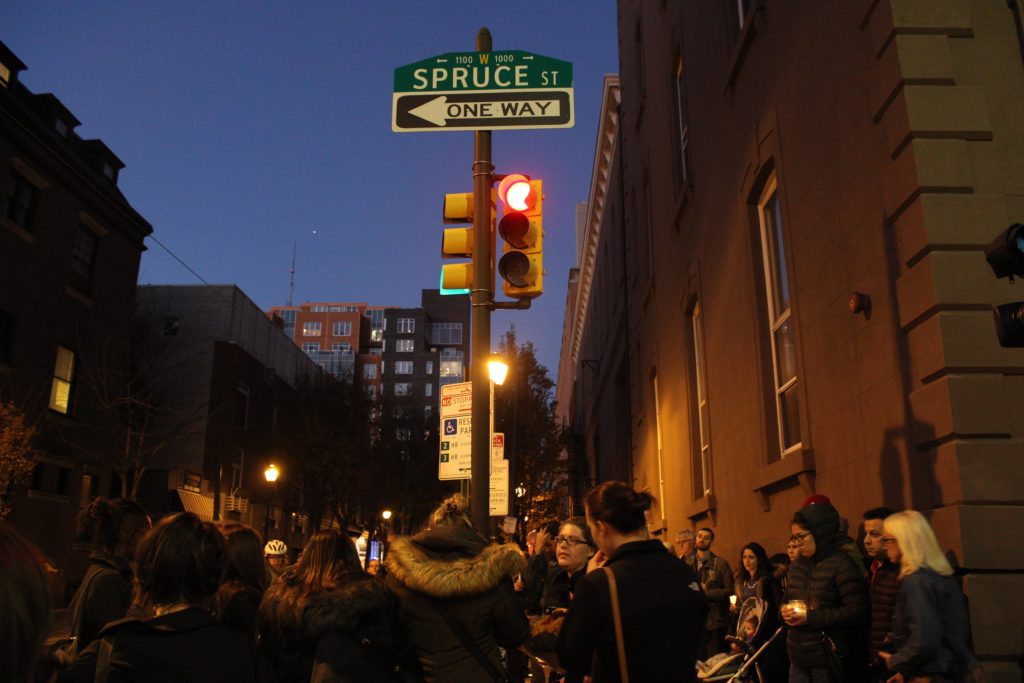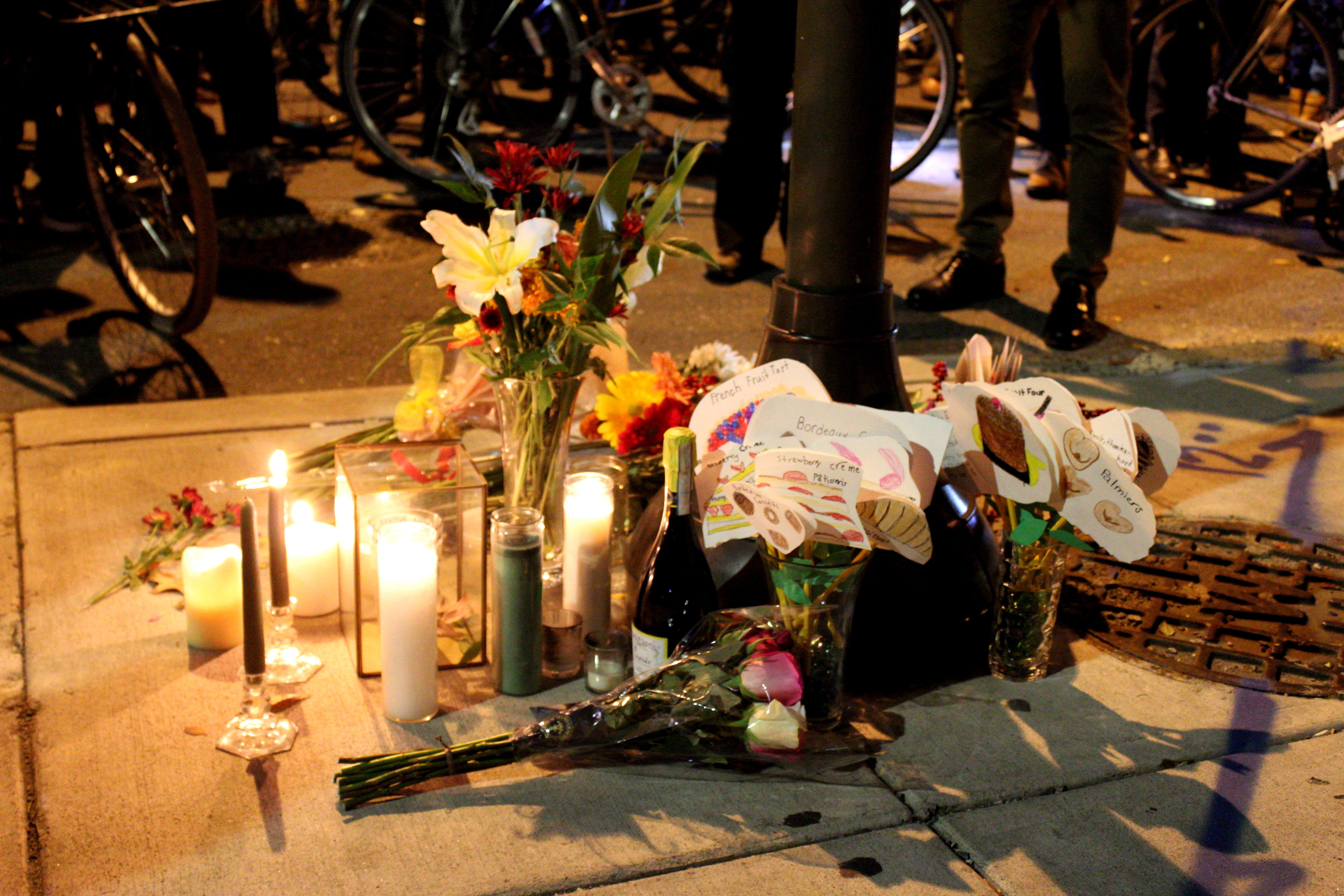
Philadelphia has the highest rate of traffic deaths per capita in the US. According to a National Highway Traffic Safety Administration report using data from 2015, six people for every 100,000 residents died in a traffic related incident. That’s over three times higher than Boston, and more than twice as high as New York City. Cyclists and pedestrians make up 45% of those killed in these traffic incidents.
It’s important to acknowledge these are not accidents, but instead preventable crashes that need to be addressed immediately. Sadly, action will come too late for Emily Fredricks who was killed by a private garbage truck as she rode in the bike lane along Spruce Street last week.
Cyclists who spend any amount of time commuting through Center City know this heavily trafficked area can be extremely dangerous. According to the Bicycle Coalition, a 2015 study counted 212 cyclists per hour passing through 13th and Spruce, just two blocks away from the crash. Emily’s death shows that painted bike lanes no longer meet the demands of increased bicycle traffic in this section, and protected bike lanes must be installed along Spruce and Pine Streets to prevent future fatalities.

How to protect cyclists along Spruce and Pine was the first topic discussed at a recent public meeting hosted by 5th Square, Bicycle Coalition of Philadelphia, and Urban Consulate. A panel of guests including Michael Carroll, Deputy Managing Director of the Philadelphia’s Office of Transportation and Information Systems (OTIS), discussed a recent trip to Copenhagen where participants learned how that super bike friendly city operates.
However, after the panelists introduced themselves, Carroll felt the need to discuss the death of Emily Fredricks, and set the record straight on the city’s plan to add protected lanes along Spruce and Pine.
“There’s a couple things I’d like to see cleared up about that,” Carroll said. “Just to be clear there was never any point in design or plan to put any real kind of protection on Spruce and Pine.”
Carroll told the crowd of about 100 people that OTIS had been examining the possibility of protected lanes along those streets, but were in the extremely early stages of planning and securing grant money last year when news leaked to the public that they were looking into this.
“That information wasn’t really intended for broad public consumption but as things turned out it came out to the public that those were the two streets we were looking at, and that came back to the neighborhood,” Carroll said. “A lot of the folks in the neighborhood were upset.”
That outcry ultimately led to the plan being put on the backburner, and OTIS looked elsewhere for other areas that may have less resistance. According to Carroll, the administrative work to get a bike lane installed takes extremely long, and even if there was no resistance against Spruce and Pine, installation of protected lanes would not have begun until next year.
“From our perspective, we’ve got 2,500 miles of streets to look at, and there’s a lot of other candidates that were on that map that we felt like were better uses of our resources at that time to try and put protection in,” Carroll said. “Even if we had programmed those for installation, if we did find a clear path forward, this project would not have started until the Spring.”
Carroll did admit that more funding may have have helped avoid this tragedy.
“This is an instance where under more ideal circumstances, if money was available sooner, maybe we could have avoided a tragedy, but I don’t know that for a fact.” Prior to this incident, Philadelphia was securing funding and developed a plan to make sure money and ideas are available.

The city’s Vision Zero efforts include a plan to install 30 miles of protected bike lanes during Mayor Kenney’s administration. So far there are two miles. That leaves a lot of work to do, so the time is now for the Mayor’s office and City Council to move quickly on advancing these projects. The Vision Zero Task Force was created, and charged with forming a three year action plan. This plan was released earlier this fall, and you can read more about it here. The plan garnered plenty of local media attention and public support but so far little action from city government, specifically city council who since 2012 has had control over the implementation of protected bike lanes on city streets.
The last thing cyclists in Philly need is their safety in the hands of politicians, and that is exactly what is happening. The Office of Transportation and Infrastructure Systems (OTIS) needs to be in charge of these decisions, and make pedestrian and bicycle network development one of their key initiatives.
Perhaps a lack of funding for protected bike lanes is the problem? It’s not. In fact, funding has been secured on a state and federal level for pedestrian and cycling infrastructure. In March 2016, the city announced they had secured $2.67 million in federal funding with another $500,000 in local contributions to fund five projects under the “Transportation Alternatives Program” (TAP). The plan for cyclists is outlined in one of the projects. The press release states:
The final project, “Safe Spaces for Cyclists: Build a Protected Bike Network”, will include a mix of converting existing bicycle lanes into protected facilities and adding new protected bicycle lanes by adding flexible delineator posts to clearly separate vehicle and bicycle space in the right of way. The project also will include striping and signage in high priority bicycle corridors throughout the City.

The money is there, the laws are written and plans have been drawn, so why are there still only two miles of protected bike lanes in Philadelphia? The problem is the overly politicized process of road safety. City council is not only guilty of inaction, but in some cases, council members work against the implementation of protected bike lanes under the guise of community outcry.
In 2011, Councilman Greenlee proposed a bill that would require city council to approve all new bike lanes. It was adopted in 2012, and since then council has actively worked against creating protected bike lanes throughout the city. Greenlee is still blocking a bike lane along 22nd street that was proposed in 2014. Councilwoman Blackwell, seems less supportive of the protected bike lane on Chestnut St in West Philadelphia, and recently told the Inquirer, “All I do is get complaints about the lack of access to Chestnut Street.”
Over the summer, Councilman Johnson wrote a letter to OTIS rejecting the planned protected bike lanes on South and Lombard Streets in West Center City. According to the Bicycle Coalition of Philadelphia, residents were concerned that they would not be able to pull into the bike lane to unload their vehicles.
Even the very stretch of Spruce St where Emily was killed has had a protected bike lane proposed and discussed publicly since last December at a Washington Square West Civic Association meeting. Public outcry over convenience has seemingly put the project on the shelf, and the city isn’t guaranteeing protected bike lanes will ever be installed along Spruce or Pine streets. Shortly after Emily’s death, the bike lane along Spruce Street was re-striped. This is simply too little too late, and still allows motorists to cross into the bike lane. City council must take the politics out of protected bike lanes, and start protecting the lives of people who choose to commute by bike.
Please take a moment to write or call your councilperson today. Tell them how important it is to you that they move forward on protected bike lanes, even at the expense of convenience for motorists. Explain that this is literally a matter of life and death in some cases, and you expect quick action from them. Do this especially if you are in Councilman Johnson or Councilman Squilla’s districts. Contact information to city council can be found here.

